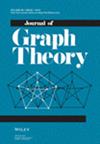三临界有符号图形的密度
IF 0.9
3区 数学
Q2 MATHEMATICS
引用次数: 0
摘要
如果一个有符号图不是可着色的,但它的每一个适当子图都是可着色的,我们就说这个图是-临界的。利用 Naserasr、Wang 和 Zhu 所提出的可着色性定义扩展了圆形可着色性的概念,我们证明了每个顶点上的三临界有符号图都至少有边,而且这个约束是渐近紧密的。由此可见,每个周长至少为 6 的有符号平面图或投影平面图都是(循环)3-可着色的,而且对于投影平面图来说,这个周长条件是最好的。为了证明我们的主要结果,我们用有符号图的同态存在来重新表述,有符号图是在每个顶点上都有一个负循环的正三角形。本文章由计算机程序翻译,如有差异,请以英文原文为准。
Density of 3-critical signed graphs
We say that a signed graph is -critical if it is not -colorable but every one of its proper subgraphs is -colorable. Using the definition of colorability due to Naserasr, Wang, and Zhu that extends the notion of circular colorability, we prove that every 3-critical signed graph on vertices has at least edges, and that this bound is asymptotically tight. It follows that every signed planar or projective-planar graph of girth at least 6 is (circular) 3-colorable, and for the projective-planar case, this girth condition is best possible. To prove our main result, we reformulate it in terms of the existence of a homomorphism to the signed graph , which is the positive triangle augmented with a negative loop on each vertex.
求助全文
通过发布文献求助,成功后即可免费获取论文全文。
去求助
来源期刊

Journal of Graph Theory
数学-数学
CiteScore
1.60
自引率
22.20%
发文量
130
审稿时长
6-12 weeks
期刊介绍:
The Journal of Graph Theory is devoted to a variety of topics in graph theory, such as structural results about graphs, graph algorithms with theoretical emphasis, and discrete optimization on graphs. The scope of the journal also includes related areas in combinatorics and the interaction of graph theory with other mathematical sciences.
A subscription to the Journal of Graph Theory includes a subscription to the Journal of Combinatorial Designs .
 求助内容:
求助内容: 应助结果提醒方式:
应助结果提醒方式:


